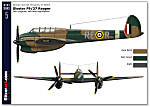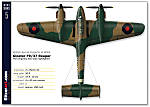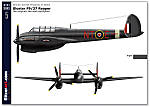1⁄35WW2 British Secret Projects Vol. 1
5
Comments

For this set we take a look at the other side of the 'Luft 46 page, so to speak, showing how the featured British aircraft designs may have looked if they had been given the go-ahead and entered service.
In fact I’ve wanted to do a set like this for ages and have discussed this on and off with Rowan (Merlin) in the past. And it's great thanks to Rowan for generously providing all the required references and data that made this set possible.
The Aircraft (in alphabetical order):
BOULTON PAUL
Boulton Paul produced a whole family of low/medium altitude fighter designs and derivatives in answer to the Air Ministry’s spec F6/42. Here we take a look of two of them.Boulton Paul P99
A pusher, twin boom layout with the unusual placement of the tail fin right in the middle of the tail plane. The cockpit was well forward giving excellent field of vision for the pilot.
Boulton Paul P100 A contraprop pusher layout with advanced swept main wings to aft and high mounted canard wings forward, immediately behind the extreme forward cockpit giving excellent field of vision for the pilot.
While offering many advantages, the prop pusher layout had one critical problem. That being, in an emergency, pilot escape was a very risky exercise in that the props would be in the direct path of the escaping pilot.
Boulton Paul envisaged a novel escape system being adopted on both P99 and P100 designs. The forward lower third of the fuselage directly under the cockpit would hinge out and down like jaws to allow the pilot to escape (see Diagram 1).
While the Boulton Paul designs attracted much interest, they were rejected by the Air Ministry as being “too advanced”. In fact, many features can be seen today on modern fighter aircraft.
BRISTOL
In answer to Air Ministry spec F18/37, Bristol produced a versatile design that accommodated a number of potential power plants including the Napier Sabre, Rolls Royce Vulture and the Bristol Centaurus featured in the profile here.Bristol F18/37 Centaurus version A dumpy little fighter design with a small twin fin tail arrangement. In fact a number of popular farm vegetables come to mind to describe the shape. A number of powerplants were catered for, all exhausting along the flanks of the fuselage through extended chambers emerging just aft and below the cockpit.
FOLLAND
Folland Fo117 A more conventional design, albeit very compact, featuring a 6 blade contra-prop powered by the Napier Sabre or Bristol Centaurus.GLOSTER
Gloster F Another pusher prop design with a twin boom layout reminiscent of the SAAB J21. The Gloster design offered a solid nose to house in this case an armament of 8 guns. Overall the design offered an attractive, small and compact aircraft. The Air Ministry decided against Gloster’s concept, deeming it, as with the Boulton Paul designs, too advanced. Gloster “Reaper” The Gloster Reaper was made in prototype form, but in a different guise to the one illustrated here (See photo).The version illustrated here is the two seat nightfighter. I chose to do two colour schemes, one with night undersides with Dark Earth and Dark Green upper surfaces and one in an all-night finish.
There seems to have been quite a few “Reaper” designs including single seat and two seat versions, plus power plant alternatives including the Merlin, Peregrine and Taurus. One design based on the two seater had guns housed in the second seat area firing up and forward over the head of the pilot.
SUPERMARINE
Supermarine Type 327 At least at first glance the Type 327 looks like a twin engined Spitfire having a pair of Merlins and the familiar elliptical wing shape. In fact it was to a design spec requested by the Air Ministry to actually replace the Spit just as it was entering service.The 327 was basically an updated version of the 324 with 6 cannon embedded in the wing roots, replacing the 324’s 12 machine guns mounted in the wings’ outer panels outboard of the engine nacelles.
More on the way. Until next time...
Comments
Many belated thanks to Rowan for publishing....another great job.
Now you have an itch you CAN scratch Rowan :-)
Cheers and thanks
Peter
:-)
NOV 22, 2006 - 10:33 AM
Great feature - I really enjoyed it! Just as I did with all the other features on German projects.
Keep 'em coming!
NOV 22, 2006 - 01:58 PM
Ahhh...what a shame they were only drawing board and mock-up projects.
Glad to see Peter has brought some of my favorite 'what-ifs?' to life.
Jeff W.
NOV 23, 2006 - 01:07 PM
This seems more 'out of the box' that many of the British prototypes that were being developed (most of which were very conservative in design) and much more inline with the late war German innovation.
Why do you think it was that the Germans were much more willing to be creative with their aircraft designs - than their British counterparts? And why, when Whittle had such a good start with jet design does it seem that we settled for piston engined designs converted to accommodate jet engines...
Were there no outlandish British jet prototypes?
Cheers, Steve
AUG 05, 2009 - 07:55 AM
maybe the germans were more creative because they were desperate? they knew they were losing the war and would try anything...
as for converting piston engined designs,you have something that is tryed and tested in the respect of aerodynamics,strength etc,thats most of your work already done for you instead of designing something new from the ground up,it takes less time and resources,especially in wartime.
AUG 05, 2009 - 11:19 PM
Copyright ©2021 by Peter Allen. Images also by copyright holder unless otherwise noted. The views and opinions expressed herein are solely the views and opinions of the authors and/or contributors to this Web site and do not necessarily represent the views and/or opinions of AeroScale, KitMaker Network, or Silver Star Enterrpises. Images also by copyright holder unless otherwise noted. Opinions expressed are those of the author(s) and not necessarily those of AeroScale. All rights reserved. Originally published on: 2006-11-19 00:00:00. Unique Reads: 68138



























